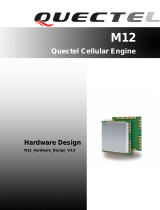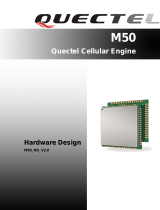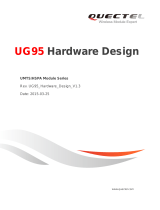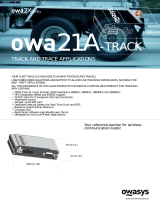Page is loading ...

M85 Hardware Design
GSM/GPRS Module Series
Rev. M85_Hardware_Design_V1.0
Date: 2013-07-17
www.quectel.com

GSM/GPRS Module
M85 Hardware Design
M85_Hardware_Design Confidential / Released 1 / 92
Our aim is to provide customers with timely and comprehensive service. For any
assistance, please contact our company headquarter:
Quectel Wireless Solutions Co., Ltd.
Room 501, Building 13, No.99, Tianzhou Road, Shanghai, China, 200233
Tel: +86 21 5108 6236
Mail: info@quectel.com
Or our local office, for more information, please visit:
http://www.quectel.com/support/techsupport.aspx
For technical support, to report documentation errors, please visit:
http://www.quectel.com/support/salesupport.aspx
GENERAL NOTES
QUECTEL OFFERS THIS INFORMATION AS A SERVICE TO ITS CUSTOMERS. THE INFORMATION
PROVIDED IS BASED UPON CUSTOMERS’ REQUIREMENTS. QUECTEL MAKES EVERY EFFORT
TO ENSURE THE QUALITY OF THE INFORMATION IT MAKES AVAILABLE. QUECTEL DOES NOT
MAKE ANY WARRANTY AS TO THE INFORMATION CONTAINED HEREIN, AND DOES NOT ACCEPT
ANY LIABILITY FOR ANY INJURY, LOSS OR DAMAGE OF ANY KIND INCURRED BY USE OF OR
RELIANCE UPON THE INFORMATION. ALL INFORMATION SUPPLIED HEREIN ARE SUBJECT TO
CHANGE WITHOUT PRIOR NOTICE.
COPYRIGHT
THIS INFORMATION CONTAINED HERE IS PROPRIETARY TECHNICAL INFORMATION OF
QUECTEL CO., LTD. TRANSMITTABLE, REPRODUCTION, DISSEMINATION AND EDITING OF THIS
DOCUMENT AS WELL AS UTILIZATION OF THIS CONTENTS ARE FORBIDDEN WITHOUT
PERMISSION. OFFENDERS WILL BE HELD LIABLE FOR PAYMENT OF DAMAGES. ALL RIGHTS ARE
RESERVED IN THE EVENT OF A PATENT GRANT OR REGISTRATION OF A UTILITY MODEL OR
DESIGN.
Copyright © Quectel Wireless Solutions Co., Ltd. 2013. All rights reserved.
Quectel
Confidential

GSM/GPRS Module
M85 Hardware Design
M85_Hardware_Design Confidential / Released 2 / 92
About the document
History
Revision
Date
Author
Description
1.0
2012-07-17
Winter CHEN
Initial
Quectel
Confidential

GSM/GPRS Module
M85 Hardware Design
M85_Hardware_Design Confidential / Released 3 / 92
Contents
About the document ................................................................................................................................... 2
Table Index ................................................................................................................................................... 6
Figure Index ................................................................................................................................................. 7
1 Introduction .......................................................................................................................................... 9
1.1. Safety Information ................................................................................................................... 9
2 Product Concept ................................................................................................................................ 11
2.1. General Description ............................................................................................................... 11
2.2. Key Features ......................................................................................................................... 11
2.3. Functional Diagram ............................................................................................................... 13
2.4. Evaluation Board ................................................................................................................... 14
3 Application Interface ......................................................................................................................... 15
3.1. Pin Of Module ........................................................................................................................ 15
3.1.1. Pin Assignment .............................................................................................................. 15
3.1.2. Pin Description ............................................................................................................... 18
3.2. Operating Modes ................................................................................................................... 23
3.3. Power Supply ........................................................................................................................ 25
3.3.1. Power Features of Module ............................................................................................. 25
3.3.2. Decrease Supply Voltage Drop ...................................................................................... 25
3.3.3. Reference Design For Power Supply ............................................................................ 26
3.3.4. Monitor Power Supply .................................................................................................... 27
3.4. Power On and Down Scenarios ............................................................................................ 27
3.4.1. Power On ....................................................................................................................... 27
3.4.2. Power Down ................................................................................................................... 29
3.4.2.1. Power Down Module Using the PWRKEY Pin ................................................ 29
3.4.2.2. Power Down Module Using AT Command ...................................................... 30
3.4.2.3. Over-voltage or Under-voltage Automatic Shutdown ...................................... 30
3.4.2.4. Emergency Shutdown Using EMERG_OFF Pin ............................................. 31
3.4.3. Restart ............................................................................................................................ 32
3.5. Power Saving ........................................................................................................................ 33
3.5.1. Minimum Functionality Mode ......................................................................................... 33
3.5.2. SLEEP Mode .................................................................................................................. 34
3.5.3. Wake Up Module From SLEEP Mode ........................................................................... 34
3.5.4. Summary Of State Transition ......................................................................................... 34
3.6. RTC Backup .......................................................................................................................... 35
3.7. Serial Interfaces ..................................................................................................................... 36
3.7.1. UART Port ...................................................................................................................... 38
3.7.1.1. The Features of UART Port ............................................................................. 38
3.7.1.2. The Connection of UART ................................................................................ 39
3.7.1.3. Firmware Upgrade ........................................................................................... 41
3.7.2. Debug Port ..................................................................................................................... 42
3.7.3. Auxiliary UART Port ....................................................................................................... 42
Quectel
Confidential

GSM/GPRS Module
M85 Hardware Design
M85_Hardware_Design Confidential / Released 4 / 92
3.7.4. UART Application ........................................................................................................... 43
3.8. Audio Interfaces ..................................................................................................................... 45
3.8.1. Decrease TDD Noise and Other Noise .......................................................................... 46
3.8.2. Microphone Interfaces Design ....................................................................................... 47
3.8.3. Receiver and Speaker Interface Design ........................................................................ 48
3.8.4. Earphone Interface Design ............................................................................................ 49
3.8.5. Loud Speaker Interface Design...................................................................................... 50
3.8.6. Audio Characteristics ..................................................................................................... 50
3.9. Dual-SIM Card Interface ........................................................................................................ 51
3.9.1. SIM Card Application ...................................................................................................... 51
3.9.2. 6 Pin SIM Cassette ........................................................................................................ 54
3.9.3. 8-Pin SIM Card Holder ................................................................................................... 56
3.10. SD Card Interface .................................................................................................................. 57
3.11. PCM Interface ........................................................................................................................ 59
3.11.1. Configuration .................................................................................................................. 59
3.11.2. Timing ............................................................................................................................. 60
3.11.3. Reference Design .......................................................................................................... 62
3.11.4. AT Command ................................................................................................................. 62
3.12. ADC ....................................................................................................................................... 63
3.13. Behaviors Of The RI .............................................................................................................. 64
3.14. Network Status Indication ...................................................................................................... 66
3.15. Operating Status Indication ................................................................................................... 66
4 Antenna Interface ............................................................................................................................... 68
4.1. RF Reference Design ............................................................................................................ 68
4.2. RF Output Power ................................................................................................................... 69
4.3. RF Receiving Sensitivity ........................................................................................................ 69
4.4. Operating Frequencies .......................................................................................................... 70
4.5. RF Cable Soldering ............................................................................................................... 70
5 Electrical, Reliability and Radio Characteristics ............................................................................ 71
5.1. Absolute Maximum Ratings................................................................................................... 71
5.2. Operating Temperature ......................................................................................................... 71
5.3. Power Supply Ratings ........................................................................................................... 72
5.4. Current Consumption ............................................................................................................ 73
5.5. Electro-static Discharge ........................................................................................................ 76
6 Mechanical Dimensions .................................................................................................................... 77
6.1. Mechanical Dimensions Of Module ....................................................................................... 77
6.2. Recommended Footprint ....................................................................................................... 79
6.3. Top View of the Module ......................................................................................................... 80
6.4. Bottom View of the Module ................................................................................................... 80
7 Storage and Manufacturing .............................................................................................................. 81
7.1. Storage .................................................................................................................................. 81
7.2. Soldering ............................................................................................................................... 82
Quectel
Confidential

GSM/GPRS Module
M85 Hardware Design
M85_Hardware_Design Confidential / Released 5 / 92
7.3. Packaging .............................................................................................................................. 83
8 Appendix A Reference ....................................................................................................................... 85
9 Appendix B GPRS Coding Scheme ................................................................................................. 90
10 Appendix C GPRS Multi-slot Class .................................................................................................. 92
Quectel
Confidential

GSM/GPRS Module
M85 Hardware Design
M85_Hardware_Design Confidential / Released 6 / 92
Table Index
TABLE 1: MODULE KEY FEATURES ................................................................................................................ 11
TABLE 2: CODING SCHEMES AND MAXIMUM NET DATA RATES OVER AIR INTERFACE ........................ 13
TABLE 3: M85 PIN ASSIGNMENT .................................................................................................................... 17
TABLE 4: PIN DESCRIPTION ........................................................................................................................... 18
TABLE 5: OVERVIEW OF OPERATING MODES ............................................................................................. 23
TABLE 6: SUMMARY OF STATE TRANSITION ............................................................................................... 34
TABLE 7: LOGIC LEVELS OF THE UART INTERFACE .................................................................................. 37
TABLE 8: PIN DEFINITION OF THE UART INTERFACES .............................................................................. 37
TABLE 9: PIN DEFINITION OF AUDIO INTERFACE ....................................................................................... 45
TABLE 10: AOUT3 OUTPUT CHARACTERISTICS .......................................................................................... 46
TABLE 11: TYPICAL ELECTRET MICROPHONE CHARACTERISTICS ......................................................... 50
TABLE 12: TYPICAL SPEAKER CHARACTERISTICS .................................................................................... 50
TABLE 13: PIN DEFINITION OF THE SIM INTERFACE .................................................................................. 51
TABLE 14: PIN DESCRIPTION OF AMPHENOL SIM CARD HOLDER ........................................................... 55
TABLE 15: PIN DESCRIPTION OF MOLEX SIM CARD HOLDER .................................................................. 56
TABLE 16: PIN DEFINITION OF THE SD CARD INTERFACE ........................................................................ 57
TABLE 17: PIN DEFINITION FOR SD/MMC ..................................................................................................... 58
TABLE 18: PIN DEFINITION OF PCM INTERFACE ......................................................................................... 59
TABLE 19: CONFIGURATION ........................................................................................................................... 60
TABLE 20: QPCMON COMMAND DESCRIPTION .......................................................................................... 62
TABLE 21: QPCMVOL COMMAND DESCRIPTION ......................................................................................... 63
TABLE 22: PIN DEFINITION OF THE ADC ...................................................................................................... 63
TABLE 23: CHARACTERISTICS OF THE ADC ................................................................................................ 63
TABLE 24: BEHAVIORS OF THE RI ................................................................................................................. 64
TABLE 25: WORKING STATE OF THE NETLIGHT .......................................................................................... 66
TABLE 26: PIN DEFINITION OF THE STATUS ................................................................................................ 67
TABLE 27: PIN DEFINITION OF THE RF_ANT ................................................................................................ 68
TABLE 28: THE MODULE CONDUCTED RF OUTPUT POWER .................................................................... 69
TABLE 29: THE MODULE CONDUCTED RF RECEIVING SENSITIVITY ....................................................... 69
TABLE 30: THE MODULE OPERATING FREQUENCIES ................................................................................ 70
TABLE 31: ABSOLUTE MAXIMUM RATINGS .................................................................................................. 71
TABLE 32: OPERATING TEMPERATURE ........................................................................................................ 71
TABLE 33: THE MODULE POWER SUPPLY RATINGS .................................................................................. 72
TABLE 34: THE MODULE CURRENT CONSUMPTION .................................................................................. 73
TABLE 35: THE ESD ENDURANCE (TEMPERATURE:25℃,HUMIDITY:45 %) .............................................. 76
TABLE 36: RELATED DOCUMENTS ................................................................................................................ 85
TABLE 37: TERMS AND ABBREVIATIONS ...................................................................................................... 86
TABLE 38: DESCRIPTION OF DIFFERENT CODING SCHEMES .................................................................. 90
TABLE 39: GPRS MULTI-SLOT CLASSES ...................................................................................................... 92
Quectel
Confidential

GSM/GPRS Module
M85 Hardware Design
M85_Hardware_Design Confidential / Released 7 / 92
Figure Index
FIGURE 1: MODULE FUNCTIONAL DIAGRAM ............................................................................................... 14
FIGURE 2: PIN ASSIGNMENT ......................................................................................................................... 16
FIGURE 3: VOLTAGE RIPPLE DURING TRANSMITTING .............................................................................. 25
FIGURE 4: REFERENCE CIRCUIT FOR THE VBAT INPUT ........................................................................... 26
FIGURE 5: REFERENCE CIRCUIT FOR POWER SUPPLY ............................................................................ 26
FIGURE 6: TURN ON THE MODULE WITH AN OPEN-COLLECTOR DRIVER .............................................. 27
FIGURE 7: TURN ON THE MODULE WITH A BUTTON .................................................................................. 28
FIGURE 8: TURN-ON TIMING .......................................................................................................................... 28
FIGURE 9: TURN-OFF TIMING ........................................................................................................................ 29
FIGURE 10: AN OPEN-COLLECTOR DRIVER FOR EMERG_OFF ................................................................ 31
FIGURE 11: REFERENCE CIRCUIT FOR EMERG_OFF BY USING BUTTON .............................................. 32
FIGURE 12: TIMING OF RESTARTING SYSTEM ............................................................................................ 32
FIGURE 13: TIMING OF RESTARTING SYSTEM AFTER EMERGENCY SHUTDOWN ................................ 33
FIGURE 14: RTC SUPPLY FROM A NON-CHARGEABLE BATTERY ............................................................. 35
FIGURE 15: RTC SUPPLY FROM A RECHARGEABLE BATTERY ................................................................. 35
FIGURE 16: RTC SUPPLY FROM A CAPACITOR ........................................................................................... 36
FIGURE 17: CHARGING CHARACTERISTICS OF SEIKO’S XH414H-IV01E ................................................ 36
FIGURE 18: REFERENCE DESIGN FOR FULL-FUNCTION UART ................................................................ 40
FIGURE 19: REFERENCE DESIGN FOR UART PORT ................................................................................... 40
FIGURE 20: REFERENCE DESIGN FOR UART PORT WITH HARDWARE FLOW CONTROL .................... 41
FIGURE 21: REFERENCE DESIGN FOR FIRMWARE UPGRADE ................................................................. 41
FIGURE 22: REFERENCE DESIGN FOR DEBUG PORT ............................................................................... 42
FIGURE 23: REFERENCE DESIGN FOR AUXILIARY UART PORT ............................................................... 43
FIGURE 24: LEVEL MATCH DESIGN FOR 3.3V SYSTEM .............................................................................. 43
FIGURE 25: LEVEL MATCH DESIGN FOR 5V SYSTEM ................................................................................. 44
FIGURE 26: LEVEL MATCH DESIGN FOR RS-232 ......................................................................................... 44
FIGURE 27: REFERENCE DESIGN FOR AIN1&AIN2 ..................................................................................... 47
FIGURE 28: REFERENCE DESIGN FOR AOUT1 ........................................................................................... 48
FIGURE 29: HANDSET INTERFACE DESIGN FOR AOUT2 ........................................................................... 48
FIGURE 30: SPEAKER INTERFACE DESIGN WITH AN AMPLIFIER FOR AOUT2 ....................................... 49
FIGURE 31: EARPHONE INTERFACE DESIGN .............................................................................................. 49
FIGURE 32: LOUD SPEAKER INTERFACE DESIGN ...................................................................................... 50
FIGURE 33: REFERENCE CIRCUIT FOR SIM1 INTERFACE WITH 8-PIN SIM CARD HOLDER ................. 52
FIGURE 34: REFERENCE CIRCUIT FOR SIM1 INTERFACE WITH THE 6-PIN SIM CARD HOLDER ......... 53
FIGURE 35: REFERENCE CIRCUIT FOR SIM2 INTERFACE WITH THE 6-PIN SIM CARD HOLDER ......... 53
FIGURE 36: AMPHENOL C707 10M006 512 2 SIM CARD HOLDER .............................................................. 55
FIGURE 37: MOLEX 91228 SIM CARD HOLDER ............................................................................................ 56
FIGURE 38: REFERENCE CIRCUIT FOR MICRO SD CARD ......................................................................... 58
FIGURE 39: LONG SYNCHRONIZATION & SIGN EXTENSION DIAGRAM ................................................... 60
FIGURE 40: LONG SYNCHRONIZATION & ZERO PADDING DIAGRAM....................................................... 61
FIGURE 41: SHORT SYNCHRONIZATION & SIGN EXTENSION DIAGRAM ................................................. 61
Quectel
Confidential

GSM/GPRS Module
M85 Hardware Design
M85_Hardware_Design Confidential / Released 8 / 92
FIGURE 42: SHORT SYNCHRONIZATION & ZERO PADDING DIAGRAM .................................................... 61
FIGURE 43: REFERENCE DESIGN FOR PCM ............................................................................................... 62
FIGURE 44: RI BEHAVIOR OF VOICE CALLING AS A RECEIVER ................................................................ 64
FIGURE 45: RI BEHAVIOR OF DATA CALLING AS A RECEIVER .................................................................. 65
FIGURE 46: RI BEHAVIOR AS A CALLER ....................................................................................................... 65
FIGURE 47: RI BEHAVIOR OF URC OR SMS RECEIVED ............................................................................. 65
FIGURE 48: REFERENCE DESIGN FOR NETLIGHT ..................................................................................... 66
FIGURE 49: REFERENCE DESIGN FOR STATUS .......................................................................................... 67
FIGURE 50: REFERENCE DESIGN FOR RF .................................................................................................. 68
FIGURE 51: RF SOLDERING SAMPLE ........................................................................................................... 70
FIGURE 52: M85 MODULE TOP AND SIDE DIMENSIONS (UNIT: MM) ......................................................... 77
FIGURE 53: M85 MODULE BOTTOM DIMENSIONS (UNIT: MM) ................................................................... 78
FIGURE 54: THE PAD DIMENSIONS (UNIT: MM) ........................................................................................... 78
FIGURE 55: RECOMMENDED FOOTPRINT ( UNIT: MM ) .............................................................................. 79
FIGURE 56: TOP VIEW OF THE MODULE ...................................................................................................... 80
FIGURE 57: BOTTOM VIEW OF THE MODULE .............................................................................................. 80
FIGURE 58: RAMP-SOAK-SPIKE REFLOW PROFILE .................................................................................... 82
FIGURE 59: TAPE AND REEL INFORMATION ................................................................................................ 84
FIGURE 60: RADIO BLOCK STRUCTURE OF CS-1, CS-2 AND CS-3 ........................................................... 90
FIGURE 61: RADIO BLOCK STRUCTURE OF CS-4 ....................................................................................... 91
Quectel
Confidential

GSM/GPRS Module
M85 Hardware Design
M85_Hardware_Design Confidential / Released 9 / 92
1 Introduction
This document defines the M85 module and describes its hardware interface which are connected with
the customer application and the air interface.
This document can help you quickly understand module interface specifications, electrical and
mechanical details. Associated with application notes and user guide, you can use M85 module to design
and set up mobile applications easily.
1.1. Safety Information
The following safety precautions must be observed during all phases of the operation, such as usage,
service or repair of any cellular terminal or mobile incorporating M85 module. Manufacturers of the
cellular terminal should send the following safety information to users and operating personnel and to
incorporate these guidelines into all manuals supplied with the product. If not so, Quectel does not take on
any liability for customer failure to comply with these precautions.
Full attention must be given to driving at all times in order to reduce the risk of an
accident. Using a mobie while driving (even with a handsfree kit) cause distraction
and can lead to an accident. You must comply with laws and regulations restrcting
the use of wireless devices while driving.
Switch off the cellular terminal or mobile before boarding an aircraft. Make sure it
switched off. The operation of wireless appliances in an aircraft is forbidden to
prevent interference with communication systems. Consult the airline staff about
the use of wireless devices on boarding the aircraft, if your device offers a Fight
Mode which must be enabled prior to boarding an aircraft.
Switch off your wireless device when in hospitals or clinics or other health care
facilities. These requests are desinged to prevent possible interference with
sentitive medical equipment.
Quectel
Confidential

GSM/GPRS Module
M85 Hardware Design
M85_Hardware_Design Confidential / Released 10 / 92
GSM cellular terminals or mobiles operate over radio frequency signal and cellular
network and cannot be guaranteed to connect in all conditions, for example no
mobile fee or an invalid SIM card. While you are in this condition and need
emergent help, Please Remember using emergency call. In order to make or
receive call, the cellular terminal or mobile must be switched on and in a service
area with adequate cellular signal strength.
Your cellular terminal or mobile contains a transmitter and receiver. When it is ON ,
it receives and transmits radio frequency energy. RF interference can occur if it is
used close to TV set, radio, computer or other electric equipment.
In locations with potencially explosive atmospheres, obey all posted signs to turn
off wireless devices such as your phone or other cellular terminals. Areas with
potencially exposive atmospheres including fuelling areas, below decks on boats,
fuel or chemical transfer or storage facilities, areas where the air contains
chemicals or particles such as grain, dust or metal powders.
Quectel
Confidential

GSM/GPRS Module
M85 Hardware Design
M85_Hardware_Design Confidential / Released 11 / 92
2 Product Concept
2.1. General Description
M85 is a Quad-band GSM/GPRS engine that works at frequencies of GSM850MHz, GSM900MHz,
DCS1800MHz and PCS1900MHz. The M85 features GPRS multi-slot class 12 and supports the GPRS
coding schemes CS-1, CS-2, CS-3 and CS-4. For more details about GPRS multi-slot classes and coding
schemes, please refer to the Appendix B & C.
With a tiny profile of 24.5mm×25.3mm×2.6mm, the module can meet almost all the requirements for M2M
applications, including Vehicles and Personal Tracking, Security System, Wireless POS, Industrial PDA,
Smart Metering, and Remote Maintenance & Control, etc.
M85 is an SMD type module with LCC package, which can be easily embedded into applications. It
provides abundant hardware interfaces like PCM and Dual SIM Card Interface.
Designed with power saving technique, the current consumption of M85 is as low as 1.3 mA in SLEEP
mode when DRX is 5.
M85 is integrated with Internet service protocols, such as TCP/UDP, FTP and PPP. Extended AT
commands have been developed for you to use these Internet service protocols easily.
The module fully complies with the RoHS directive of the European Union.
2.2. Key Features
The following table describes the detailed features of M85 module.
Table 1: Module Key Features
Feature
Implementation
Power supply
Single supply voltage: 3.3V~4.6V
Typical supply voltage: 4V
Power saving
Typical power consumption in SLEEP mode: 1.3 mA@ DRX=5
1.2 mA@ DRX=9
Quectel
Confidential

GSM/GPRS Module
M85 Hardware Design
M85_Hardware_Design Confidential / Released 12 / 92
Frequency bands
Quad-band: GSM850, GSM900, DCS1800, PCS1900.
The module can search these frequency bands automatically
The frequency bands can be set by AT command.
Compliant to GSM Phase 2/2+
GSM class
Small MS
Transmitting power
Class 4 (2W) at GSM850 and GSM900
Class 1 (1W) at DCS1800 and PCS1900
GPRS connectivity
GPRS multi-slot class 12 (default)
GPRS multi-slot class 1~12 (configurable)
GPRS mobile station class B
Temperature range
Normal operation: -35°C ~ +80°C
Restricted operation: -40°C ~ -35°C and +80°C ~ +85°C
1)
Storage temperature: -45°C ~ +90°C
DATA GPRS:
CSD:
GPRS data downlink transfer: max. 85.6 kbps
GPRS data uplink transfer: max. 85.6 kbps
Coding scheme: CS-1, CS-2, CS-3 and CS-4
Support the protocols PAP (Password Authentication Protocol)
usually used for PPP connections
Internet service protocols TCP/UDP,FTP,PPP,HTTP,NTP,PING
Support Packet Broadcast Control Channel (PBCCH)
CSD transmission rates: 2.4, 4.8, 9.6, 14.4 kbps non-transparent
Support Unstructured Supplementary Service Data (USSD)
SMS
Text and PDU mode
SMS storage: SIM card
SIM interface
Support SIM card: 1.8V, 3V
Audio features
Speech codec modes:
Half Rate (ETS 06.20)
Full Rate (ETS 06.10)
Enhanced Full Rate (ETS 06.50 / 06.60 / 06.80)
Adaptive Multi-Rate (AMR)
Echo Suppression
Noise Reduction
Embedded one amplifier of class AB with maximum driving power up
to 800mW
UART interfaces
UART Port:
Seven lines on UART port interface
Used for AT command, GPRS data and CSD data
Multiplexing function
Support autobauding from 4800 bps to 115200 bps
Debug Port:
Two lines on debug port interface DBG_TXD and DBG_RXD
Debug Port only used for firmware debugging
Quectel
Confidential

GSM/GPRS Module
M85 Hardware Design
M85_Hardware_Design Confidential / Released 13 / 92
1)
When the module works within this temperature range, the deviations from the GSM specification may
occur. For example, the frequency error or the phase error will be increased.
Table 2: Coding schemes and maximum net data rates over air interface
2.3. Functional Diagram
The following figure shows a block diagram of M85 and illustrates the major functional parts.
Serial Flash
Radio frequency part
Power management
The Peripheral interface
—Power supply
—Turn-on/off interface
Auxiliary Port:
Used for AT command
Phonebook management
Support phonebook types: SM, ME, ON, MC, RC, DC, LD, LA
SIM Application Toolkit
Support SAT class 3, GSM 11.14 Release 99
Real time clock
Supported
Physical characteristics
Size:
25.3±0.15×24.5±0.15×2.6±0.2mm
Weight: Approx. 3.3g
Firmware upgrade
Firmware upgrade via UART Port
Antenna interface
Connected to antenna pad with 50 Ohm impedance control
Coding scheme
1 Timeslot
2 Timeslot
4 Timeslot
CS-1
9.05kbps
18.1kbps
36.2kbps
CS-2
13.4kbps
26.8kbps
53.6kbps
CS-3
15.6kbps
31.2kbps
62.4kbps
CS-4
21.4kbps
42.8kbps
85.6kbps
NOTE
Quectel
Confidential

GSM/GPRS Module
M85 Hardware Design
M85_Hardware_Design Confidential / Released 14 / 92
—UART interface
—Audio interface
—Dual-SIM interface
—SD card interface
—PCM interface
—ADC
—RF interface
ADC
Status&
Netlight
Audio
PCM
Inteface
SD
Inteface
BB&RF
RF PAM
SAW
Filter
Serial
Flash
32KHz
26MHzRF Transceiver
Audio
RTC
GPIO
Serial
Interfac
e
Memory
Interface
PCM
Interface
SIM1
Interface
SIM2
Interface
ADC
RF_ANT
VBAT
PWRKEY
EMERG_OFF
VRTC
UART
SIM1
Interface
SIM2
Interface
Reset
ESD
PMU
SD
Interface
Figure 1: Module functional diagram
2.4. Evaluation Board
In order to help customer to develop applications with M85, Quectel supplies an evaluation board (EVB),
RS-232 to USB cable, power adapter, earphone, antenna and other peripherals to control or test the
module. For details, please refer to the document [12].
Quectel
Confidential

GSM/GPRS Module
M85 Hardware Design
M85_Hardware_Design Confidential / Released 15 / 92
3 Application Interface
The module adopts LCC package and has 83 pins. The following chapters provide detailed descriptions
about these pins below.
Power supply
Power on/down
RTC
Serial interfaces
Audio interfaces
Dual-SIM interface
SD interface
PCM interface
ADC
3.1. Pin Of Module
3.1.1. Pin Assignment
Quectel
Confidential

GSM/GPRS Module
M85 Hardware Design
M85_Hardware_Design Confidential / Released 16 / 92
Power
SIM1
RESERVED
PCM
Other
SD
RESERVED
NETLIGHT
LOUDSPKN
LOUDSPKP
PWRKEY
EMERG_OFF
PCM_IN
PCM_CLK
RESERVED
RESERVED
RESERVED
SIM_GND
SIM1_RST
SIM1_DATA
SIM1_CLK
SIM1_VDD
RESERVED
SIM2_VDD
SIM2_CLK
SIM2_DATA
SIM2_RST
SIM1_PRESENCE
GND
Audio
ADC
1
2
3
4
5
6
7
8
9
10
11
12
13
14
15
16
17
18
19
20 21
22
23 24 25 26 27 28 29 30 31 32 33 34
35
36 37
38
39
40
41
42
43
44
45
46
47
48
49
50
51
52
53
54
55
56
57
58
59
60
616263646566676869
70
71727374
Top view
RFSIM2
VBAT
UART
ADC0
RESERVED
SPK2P
AGND
MIC2P
MIC2N
MIC1P
MIC1N
SPK1N
SPK1P
STATUS
PCM_OUT
PCM_SYNC
RESERVED
RESERVED
RESERVED
RESERVED
RESERVED
RESERVED
RESERVED
RESERVED
RESERVED
RESERVED
RESERVED
RESERVED
SD_CMD
SD_CLK
SD_DATA0
GND
TXD_AUX
RXD_AUX
DBG_TXD
DBG_RXD
DCD
RI
DTR
CTS
TXD
RXD
RTS
VRTC
VDD_EXT
GND
GND
RF_ANT
GND
GND
GND
VBAT
VBAT
VBAT
VBAT
75
76
77
78
79
80
81
82
RESERVED
RESERVED
RESERVED
RESERVED
GND
GND
GND
GND
RESERVED
83
Figure 2: Pin assignment
Quectel
Confidential

GSM/GPRS Module
M85 Hardware Design
M85_Hardware_Design Confidential / Released 17 / 92
Table 3: M85 Pin Assignment
PIN NO.
PIN NAME
PIN NO.
PIN NAME
PIN NO.
PIN NAME
1
RESERVED
2
ADC0
3
RESERVED
4
NETLIGHT
5
SPK2P
6
AGND
7
MIC2P
8
MIC2N
9
MIC1P
10
MIC1N
11
SPK1N
12
SPK1P
13
LOUDSPKN
14
LOUDSPKP
15
PWRKEY
16
STATUS
17
EMERG_OFF
18
PCM_IN
19
PCM_CLK
20
PCM_OUT
21
PCM_SYNC
22
RESERVED
23
RESERVED
24
RESERVED
25
RESERVED
26
RESERVED
27
RESERVED
28
RESERVED
29
RESERVED
30
RESERVED
31
RESERVED
32
RESERVED
33
RESERVED
34
SD_CMD
35
SD_CLK
36
SD_DATA0
37
GND
38
RESERVED
39
RESERVED
40
TXD_AUX
41
RXD_AUX
42
DBG_TXD
43
DBG_RXD
44
RESERVED
45
DCD
46
RI
47
DTR
48
CTS
49
TXD
50
RXD
51
RTS
52
SIM_GND
53
SIM1_RST
54
SIM1_DATA
55
SIM1_CLK
56
SIM1_VDD
57
SIM1_PRESENCE
58
RESERVED
59
VRTC
60
VDD_EXT
61
GND
62
GND
63
RF_ANT
64
GND
65
GND
66
GND
67
VBAT
68
VBAT
69
VBAT
Quectel
Confidential

GSM/GPRS Module
M85 Hardware Design
M85_Hardware_Design Confidential / Released 18 / 92
Keep all reserved pins open.
3.1.2. Pin Description
Table 4: Pin Description
70
VBAT
71
SIM2_VDD
72
SIM2_CLK
73
SIM2_DATA
74
SIM2_RST
75
RESERVED
76
RESERVED
77
RESERVED
78
RESERVED
79
GND
80
GND
81
GND
82
GND
83
RESERVED
Power supply
PIN
NAME
PIN
NO.
I/O
DESCRIPTION
DC
CHARACTERISTICS
COMMENT
VBAT
67,68,
69,70
I
Main power supply of module:
VBAT=
3.3V~4.6V
Vmax= 4.6V
Vmin=3.3V
Vnorm=4.0V
Make sure that
supply sufficient
current in a
transmitting burst
typically rises to
1.6A.
VRTC
59
I/O
Power supply for RTC when
VBAT is not supplied for the
system.
Charging for backup battery or
golden capacitor when the
VBAT is applied.
VImax=3.3V
VImin=1.5V
VInorm=2.8V
VOmax=2.85V
VOmin=2.6V
VOnorm=2.8V
Iout(max)= 1mA
Iin=2.6~5 uA
If unused, keep this
pin open.
VDD_
EXT
60
O
Supply 2.8V voltage for
external circuit.
Vmax=2.9V
Vmin=2.7V
Vnorm=2.8V
Imax=20mA
1. If unused, keep
this pin open.
2. Recommend to
add a 2.2~4.7uF
bypass capacitor,
NOTE
Quectel
Confidential

GSM/GPRS Module
M85 Hardware Design
M85_Hardware_Design Confidential / Released 19 / 92
when using this pin
for power supply.
GND
37,61,
62,64~
66,
79~82,
Ground
Turn on/off
PIN NAME
PIN
NO.
I/O
DESCRIPTION
DC
CHARACTERISTICS
COMMENT
PWRKEY
15
I
Power on/off key. PWRKEY
should be pulled down for a
moment to turn on or turn off
the system.
VILmax=
0.1×VBAT
VIHmin=
0.7×VBAT
VImax=VBAT
Pulled up to VBAT
internally.
Emergency shutdown
PIN
NAME
PIN
NO.
I/O
DESCRIPTION
DC
CHARACTERISTICS
PIN NAME
EMERG_
OFF
17
I
Emergency off. Pulled down for
at least 20ms, which will turn
off the module in case of
emergency. Use it only when
shutdown via PWRKEY or AT
command cannot be achieved.
VILmax=0.4V
VIHmin=2.2V
Vopenmax=2.8V
EMERG_
OFF
Module indicator
PIN
NAME
PIN
NO.
I/O
DESCRIPTION
DC
CHARACTERISTICS
COMMENT
STATUS
16
O
Indicate module’s operating
status. Output high level when
module turns on, while output
low level when module turns
off.
VOHmin=
0.85×VDD_EXT
VOLmax=
0.15×VDD_EXT
If unused, keep this
pin open.
Audio interface
PIN
NAME
PIN
NO.
I/O
DESCRIPTION
DC
CHARACTERISTICS
COMMENT
MIC1P
MIC1N
9,
10
I
Channel 1 positive and
negative voice input
Refer to Section 3.7
If unused, keep
these pins open.
MIC2P
MIC2N
7,
8
I
Channel 2 positive and
negative voice input
Quectel
Confidential
/








